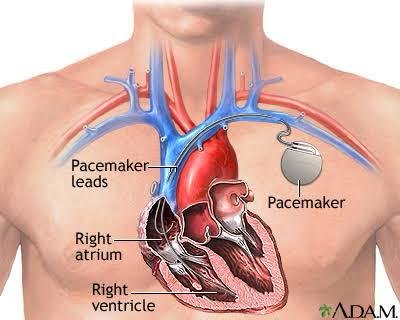Pacemaker is the implantation of a small electronic device that is usually placed in the chest (just below the collarbone) to help regulate slow electrical problems with the heart. A pacemaker may be recommended to ensure that the heartbeat does not slow to a dangerously low rate.
The type of pacemaker you may need depends on your symptoms and the specific heart condition you have. After our diagnostic evaluation, we discuss our recommendations with you to choose the right pacemaker for your needs.
Single-chamber pacemaker: This type of pacemaker has one lead that connects the pulse generator to one chamber of your heart.
For most people, we use the single-chamber pacemaker to control heartbeat pacing by connecting the lead to your right ventricle (lower heart chamber). Depending on your symptoms and the type of pacing you need, we connect the lead to your right atrium (upper heart chamber) to stimulate the pacing in that chamber.
Dual-chamber pacemaker: With two leads, this device connects to both chambers on the right side of your heart, the right atrium and the right ventricle. The doctor programs the dual-chamber pacemaker to regulate the pace of contractions of both chambers.
This pacemaker helps the two chambers work together, contracting and relaxing in the proper rhythm. The contractions allow blood to flow properly from the right atrium into the right ventricle.
Biventricular pacemaker: This pacemaker, also known as a cardiac resynchronization therapy (CRT) device, has three leads connected to the right atrium and both ventricles. We use the biventricular pacemaker to treat people with arrhythmias caused by advanced heart failure. For many people with heart failure, the left and right ventricles do not pump at the same time. Our doctors program the biventricular pacemaker to coordinate the contractions of the ventricles, so that they both pump together.
Coordinating the ventricles’ contractions helps your heart pump blood more efficiently and can relieve your heart failure symptoms. The treatment is known as cardiac resynchronization therapy because it resynchronizes the ventricles’ pumping action.
Some examples of heart rate and rhythm problems for which a pacemaker might be inserted include:
